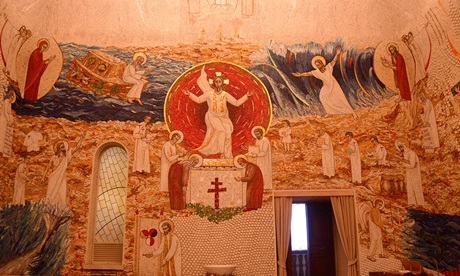As accusations of sexual abuse have mounted against Slovenian Father Marko Rupnik, his art has come under a microscope.
Recently attentive observers noted a curiosity – the face of the artist himself, along with two of his closest friends and allies, appears in an obscure section of perhaps his most famous work.
Rupnik’s mosaic
Rupnik’s giant mosaic in the Vatican’s Redemptoris Mater Chapel, sometimes dubbed the “Sistine Chapel” of the late Pope John Paul II, according to an inscription above the door, was installed by the Rupnik-founded, Rome-based Centro Aletti in 1999.
It blends eastern and western motifs in depicting the history of salvation.
Rupnik, 69, whose famed murals adorn chapels and cathedrals around the world, including inside the Vatican and at the Marian shrine of Lourdes, is accused of sexually abusing at least 30 adult women.
Many of his alleged victims are nuns belonging to the Loyola Community he helped found in his native Slovenia in the 1980s.
In a small corner of the sprawling work, three figures are depicted in white robes.
Upon examination, some say they bear striking resemblances to real people.
One was the late Czech Cardinal Tomáš Špidlík, Rupnik’s great patron, shown holding a set of books.
Another was Nataša Govekar, a member of the Centro Aletti, who today serves as a department head in the Vatican’s Dicastery for Communications, depicted with a laptop.
The third was Rupnik himself, holding a painter’s easel.
However jarring the images may seem now, Rome-based art historian Elizabeth Lev says they might actually be the least odd element of the entire Rupnik saga.
“Portraits of artists and patrons in works are very normal,” Lev told Crux, citing several examples.
Among them were Raphael painting himself into a mural in the Apostolic Palace along with Pope Julius and an advisor, Caravaggio peeking in from the “Martyrdom of Matthew,”.
That painting also shows Ghirlandaio routinely depicting friends and family, and the famous Arena Chapel in Padua where Giotto painted both Dante and Enrico degli Scrovegni, the patron of the work, into his fresco cycle.
(Lev believes the Giotto fresco may have been the inspiration for Rupnik’s work in the Redemptoris Mater.)
“Nothing unusual about it,” Lev said of artists injecting such personal flourishes into their scenes.
On the other hand, Lev said there’s a great deal unusual about the broader debate over the removal of Rupnik’s artworks which his abuse scandals have kindled – and insists that, contrary to popular opinion, things aren’t nearly as straight-forward as they may seem.
Art and history
Calling the distinction between art and artist “complicated,” Lev noted that several prominent artists whose work is featured in the Vatican and beyond have their own nefarious histories.
“Raphael was a notorious womaniser, how he seduced women is not known, but that he did is well documented,” she said.
Caravaggio himself was known for his drunken antics and at one point killed a man in a violent duel, she noted.
Famed French artist Eugène Henri Paul Gauguin was described by Lev as a “sex tourist,”.
Gian Lorenzo Bernini, whose masterpiece canopy adorning the main altar in St. Peter’s Basilica is currently being restored ahead of the upcoming Jubilee of Hope in 2025, was an adulterer, at the time a capital offense, who at one point “slashed his mistresses face.”
Likewise, Lev said that Italian artist Carlo Crivelli served time for seducing a married woman,
Then there was Italian painter Agostino Tassi a century later. He was convicted for the rape of fellow artist Artemisia Gentileschi.
Another was Italian sculptor Benvenuto Cellini, who apparently killed four men.
Accountability absent
Lev voiced her belief that the core of the problem with Rupnik is that he “seems to have had no accountability for his crimes.”
“His crimes don’t seem to have been acknowledged by the Church writ large,” she said.
She laments the growing impression that Rupnik was protected by higher-ups and continued to be promoted even after allegations were lodged “as if nothing had happened.”
The appearance of Rupnik’s artwork on missalettes and other Vatican materials, she said, “makes a mockery of the entire ‘closeness to victims’ narrative – so as the Romans once did, instead of damning the man, at least one can damn his legacy.”
However, she said the situation is more nuanced than that, and flagged several considerations that as a historian she believes ought to be part of the broader debate.
Lev noted that Rupnik’s larger projects were not completed alone, but with the help of many well-intended believing members of the Aletti Center.
“Should they be punished too? This was their time and their effort making works they thought were evangelizing – or are we saying they are all complicit?” she said.
She also noted that, in Rome and beyond, Rupnik for decades was “lionised” by the Catholic community, including many of her peers, who appeared dazzled by his works and who would go to lengths to show off any mosaics they had.
“Now those people who thought he was God’s gift to art want to dump him? How were they such blind patrons?” she asked.
“If we don’t leave the works this question will never be asked, which I consider a problem.”
Lev compared “cancelling” Rupnik to destroying Caravaggio masterpieces once news of the murder and of his gambling and promiscuity came to light.
Centuries later, “we can look at his struggle between light and dark and learn from it,” she said.
She wonders about Rupnik, asking “is there nothing we can learn from thinking about why he was so popular for so many years?” Read more
- Elise Ann Allen works as a Senior Correspondent for Crux in Rome, covering the Vatican and the global Church.
News category: Analysis and Comment.




